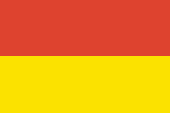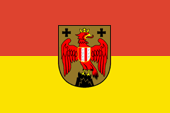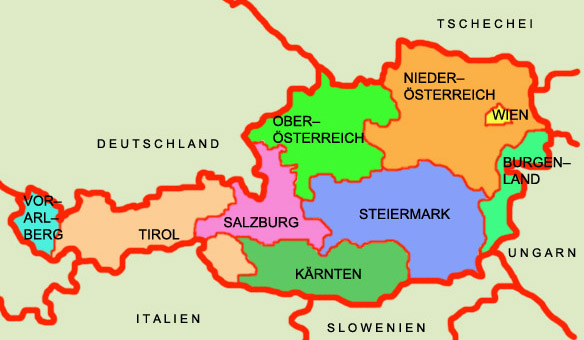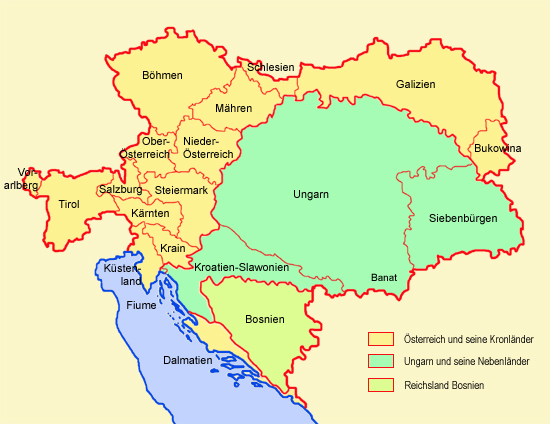mobile View, to the German Version tap the flag


- Burgenland
- Federal Country of the Republic of Austria
• Flags
• Meaning/Origin of the Flag
• Coat of Arms
• Meaning/Origin of the Coat of Arms
• Map of the federal countries of Austria
• Map of the former crown lands of Austria-Hungary (to 1918)
• Numbers and Facts
• History
• Origin of the Country's Name

Flag of the country (Colours of the country),
ratio = 2:3,
Source, by: Wikipedia (D),
Colour, by: Dr. Peter Diem www.peter-diem.at




Official flag,
ratio = 2:3,
Source, by: Wikipedia (D),
Colour, by: Dr. Peter Diem www.peter-diem.at






The flag of Burgenland was introduced on 25th of June in 1921 and shows two horizontal stripes in red and gold and was lastly confirmed on 25th of June in 1971. The colours of the flag are derived from the colours of the coat of arms (red eagle on golden ground).
Austria joined the German Empire in 1938 as one country. The federal structures played no role, they were completely replaced by the NSDAP districts (NS-Gau), the countries were abolished. Burgenland is divided between the disticts of "Styria" and "Niederdonau".
The flags of the Federal States of Austria are used with or without the coat of arms. For official use, however, they always show it. The general population is permitted to use this format as well.
There do not seem to be any legal regulations for the colours of the flags of the Austrian federal states; since they are apparently not defined, they are reproduced in practice within a usual standard range. However, the Austrian publicist and media scientist Dr. Peter Diem gives recommendations for the reproduction of the colours: For Burgenland, a bright red, most likely corresponding to Pantone 179, and yellow as 100% Y.
Source: Dr. Peter Diem austria-forum.org,
Wikipedia (D),
Flaggen Enzyklopädie,
Volker Preuß


since 1922,
Coat of arms of Burgenland,
Source, by: Wikipedia (D)

The coat of arms of Burgenland was introduced in 1922. It shows a red eagle on golden ground which sits on a rock. It carrys a chest shield which shows a threefold clefted shield in the colours red und silver. That coat of arms combines the coat of arms of the most important nobility lineages of the region, the Counts of Guessing-Bernstein and the Counts of Mattersdorf-Forchtenstein.
Source: Wikipedia (D)

The federal countries of Austria:

Source: Volker Preuß
• Burgenland
• Carinthia (Kärnten)
• Lower Austria (Niederösterreich)
• Upper Austria (Oberösterreich)
• Salzburg
• Styria (Steiermark)
• Tyrol (Tirol)
• Vorarlberg
• Vienna (Wien)

Map ca. 1910:

Source: Volker Preuß

Area: 1.530 square miles
Inhabitants: 293.500 (2019), thereof 91% German speaking Austrians, 7% Croatians, 2% Hungarians
Density of Population: 192 inh./sq.mi.
Capital: Eisenstadt, 14.650 inh. (2019)
official Language: German
other Languages: Croatian, Hungarian
Currency: 1 Euro = 100 Cent
Time Zone: MEZ
Source: Wikipedia (D)

ca. 1300 B.C. · settlement by Illyrians
ca. 400 B.C. · settlement by Celts
15 B.C. · Roman conquest, establishment of the Province of Pannonia superior
233 · invasion of the Quades
4th/5th cent. · the Burgenland belongs to the Empire of the Eastern Goth
409–452 · invasions of the Huns
6th cent. · the Burgenland belongs to the Empire of the Langobardes
since 568 · migration of the Langobardes, settlement by Awares and Slavs
788 · conquest by the Frankish Empire of the Carolingians
795 · establishment of the "Awarian Mark"
843/870/880 · at the division of the Frankish Empire comes the Awarian Mark to the East Frankish Empire (later named German Empire)
896 · Invasion of the Hungarians, the area of the today’s Burgenland becomes affiliated to Hungary
11th–13th cent. · settlement by Germans
1526 · the Habsburgs acquire from the House of Luxemburg by inheritance Bohemia, Silesia and the Lausitz, as well as after the Battle of Mohács the Hungarian Crown, the Kingdom of Hungary (including Burgenland) remains between Austria and the Turks as slender stripe, Hungary itself comes to 80% to the Turks
1st of January 1918 · due to the Austria-Hungaryn defeat in the First World War separates Hungary as independent, the Burgenland remains initially at Hungary
10th of September 1919 · Peace Treaty of Saint-Germain, recognition of Hungary by Austria, but Burgenland becomes adjudged to Austria because of the high contingent of German population and after a plebiscite, only the District of Oedenburg (Sopron) remains at Hungary
13th of March in 1938 · Annexation of Austria to the German Empire, Burgenland becomes partitioned between the the NS-Gau's of Lower Danube (Niederdonau) and Steiermark
27th of April 1945 · proclamation of the Republic of Austria "Second Republic", Burgenland becomes re-established as Austrian federal country, but stays occupied by Soviet troops to 1955
1955 · withdrawal of the occupation troops
Source: Atlas zur Geschichte,
Wikipedia (D),
World Statesmen,
RetroBib Retrobibliothek,
Discovery '97,
Volker Preuß

The name "Burgenland" has its roots in the names of the former Hungarian districts from which Burgenland was formed in 1919: Oedenburg, Eisenburg and Wieselburg
Source: Wikipedia (D)

Further Austria pages (historical flags and coats of arms):
• Empire of the Austrian Habsburgs (to 1804)
• Empire of Austria (1814–1867)
• Austria-Hungary (1867–1918)
• Republic of Austria (since 1918)

![]()











